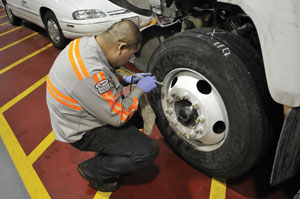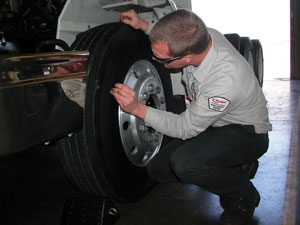Is it possible that anyone has failed to notice truck tire prices increasing dramatically, in some cases by double digits? But don’t blame the tire manufacturers. Because the production of tires requires large amounts of petroleum, you can blame the high cost of oil, along with the escalating cost of natural rubber.
Rubber used by retreaders, of course, comes with the same unfortunate burdens—and the reality is that the situation will result in an upward price pressure on retreadable casings. 
If this bothersome financial situation isn’t enough to get your attention, you can add to it the interest the new federal Compliance, Safety and Accountability (CSA) regulations pay to tires. Two tire maintenance conditions are continuing to be troublesome for fleets during roadside inspections: tread depth and inflation pressure. Lack of proper management attention to either can result in citations and/or higher tire costs than necessary.
Effective management of tire costs is more important than ever—and will continue to grow in importance—but, like anything else, if you are not able to accurately measure what your fleet spends on tires, there is no way you will be able to manage those expenses. Unfortunately, many, if not most, fleets have not initiated a comprehensive tire management program, nor do they accurately know the expense they incur for tires.
Measuring Tire Cost
Darry Stuart, president and CEO of DWS Fleet Management Services, said, “At the end of the day, it is cost per 1/32nd per mile. Most people do not have an accurate cost-per-mile for tires because of the way they do their accounting. The best way to do accurate accounting for tires is to use a good computerized system and charge tires by 32nds as they go on and credit tires the 32nds when they come off. In addition, most fleets include the price of tires in the cost of a new truck, so they fail to include the cost of those tires when they are calculating their tire cost-per-mile.”
Programs such as this, for use in-house, are commercially available and have been designed to interact seamlessly with most comprehensive maintenance management systems. They also are available through tire vendors, who will input fleet tire data then store and analyze it. Goodyear, for example, recently launched a next-generation version of its TVTrack program that is designed to do exactly what needs to be done if fleet tire costs are to be managed. It is available through the company’s dealer network and will accept and analyze cradle-to-grave financial information about any brand of tire—when it is purchased, repaired, recapped or replaced. 
Tim Miller, Goodyear’s commercial tire marketing communications manager, said, “If you manage a handful of vehicles, paper records might work. But as the number of vehicles in a fleet increases, the complexity of keeping such records becomes more difficult. To record all of the data and make the calculations needed to determine total costs—and even more important, the cost-per-mile of every tire in your fleet—spreadsheet proficiency becomes the key.”
Casing Life
Increasing tire prices also have resulted in some fleet managers modifying some practices they’ve used for years. In times past, many fleet managers would recap a casing as often as it was physically possible, but only until it was about five years old. At that point they would sell it instead of capping it again, regardless of its apparent condition.
That age criteria for many fleets has been extended a bit. Stuart said, “Some years ago most fleet managers would take a casing out of service after about five years. That increased to six years, and now, in many cases, is at seven years and in some cases eight years. The strategy has been working well, but the application those older casings go into needs to be managed. If the tire is going to be used in a low mileage trailer application, 40,000 or 50,000 miles a year, it will very likely offer you no problems. Capping technology has also improved helping to make this strategy possible.”
He also suggests that fleets should re-examine all casings that have been rejected by a retreader to see if the casing might actually be salvageable. He said, “I find that between 20% and 25% of the casings that are rejected can still be used in particular applications.”
Bridgestone Commercial Solutions has put together a strategy designed to maximize casing use, as well as tread life. The company points out that whatever tread rubber is left on a tire when you send the casing for retreading, or selling it, is lost forever, so how can you delay sending it to the retreader?
Consider a new drive tire with an inch of tread rubber that wears down to 12/32nd-in. At that point, many drivers start complaining that they’re no longer getting the pulling power they need, especially in the north during winter. As a result, many fleets will send the tire out for recapping.
Instead, how about pulling the tire and moving it to a trailer position, since it has about the same tread depth as a new or recapped trailer tire? The driver is happy and so is the accounting department, since you didn’t need another trailer tire. You can still pull that trailer tire at 6/32-in. after another 180,000 miles or so, which is much farther than it would have been had you left it on the drive axle. As Bridgestone says, “It’s an excellent strategy for extending drive tire life and reducing driver complaints.”
Pull Point
While the DOT defines 2/32-in. as a minimum tread depth, most fleets will pull tires before this to protect the casing for retreading. Stuart says, “I’m a deep rubber fan and have always been such. Road calls are very expensive, and are mainly caused by road debris. If you’re running your tires too thin, you can too easily lose a tire. DOT calls for 2/32-in. on a trailer. I’ll pull them as early as 5/32-in. I try not to go beyond 5/32-in. because of the increased possibility of debris penetration. If the unit is in the shop for a PM and the tire is at 6/32-in. or 7/32-in., there’s a good chance we’ll pull that tire off and send it off for recapping, saving the casing.”
Al Cohn, director of new market development and engineering support at Pressure Systems International (PSI), offers a recommended tire program. He says, “A typical tire program may target those steer tires to be removed with 6/32-in. to 8/32-in. of remaining tread. At that point, tires would be sent to the retreader and retreaded as a drive design. If the tire is well-maintained, the drive tire retread should be removed with about 4/32-in. to 6/32-in. of rubber and be retreaded a second time as a trailer retread. This trailer retread can now run out its life and be taken out of service at the legal limit of 2/32-in.”
Ryder Systems also has a policy of not going down to the legal limit. Scott Perry, vice president of supply management at the company, said, “The DOT legal limit is 2/32-in., but we target 4/32-in., which gives us a little bit of room to plan the replacement. We recognize the importance of the casing and not wearing the tread package too thin. Our customers are on full service leases, so they will bring their trucks into our service facilities on a regular basis, and our goal is to perform as much of the required maintenance on our leased vehicles at our facilities as possible. As a result, we have multiple ‘touch points’ throughout the year. Because of that, we can understand the rate at which a truck’s tires are wearing and can predict when the tires will need to be removed from the vehicle.”
As a result, it’s a scheduled procedure and not a road call.
Air Pressure
Inflation pressure is always the most important factor of tire maintenance relative to tire costs. Correct inflation will help to maximize retreadability while minimizing wear and the tire’s contribution to fuel economy rolling resistance. The Technology and Maintenance Council (TMC) recently released the 4th edition of its “Radial Tire Conditions Analysis Guide,” which details how low tire inflation pressure negatively affects casing condition and tire wear. The manual is an exceptional source of information for understanding and identifying most tire issues. Another excellent source of tire-related information is the PSI Tire Digest, which is published regularly and available by subscribing on the company’s website, psitiredigest.com.
According to Bridgestone Commercial Solutions, tire tread life decreases about 1% for every 1% of underinflation. Faster tire wear means fewer miles, resulting in higher tire and tire maintenance costs, because you’ll be servicing and replacing tires more often. Underinflated tires also will run hotter, which negatively affects retreadability. As a result, you could get fewer total miles per casing and/or fewer salable casings, leading to a decrease in miles and an increase in tire costs, and increased cost per mile.
Are automatic tire inflation systems a good idea, then? Definitely, in some applications. Ryder made a decision about five years ago to equip its trailers with PSI systems because of the nomadic nature of those vehicles. The company considers a tire to be flat if it is less that 10 PSI less than one of the other tires on that axle when it comes across a company fuel island.
Perry said, “We encourage our customers to do more than the bump with the stick. We’ll go as far as issuing drivers pressure gauges.”
Tire expense will always be a way of life for fleet managers. It only makes sense to establish procedures designed to control them. Maximize casing life and when a tire comes out of service make sure you know why. Use retreads. Keep tires aired to the correct pressure.













